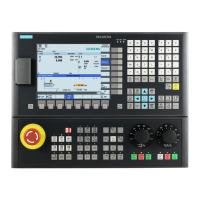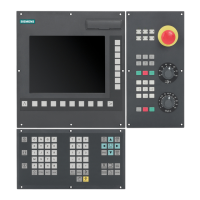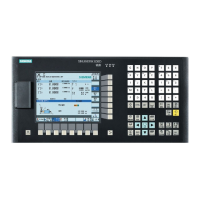Z2: NC/PLC interface signals
18.3 Manual and Handwheel Travel (H1)
Extended Functions
872 Function Manual, 03/2013, 6FC5397-1BP40-3BA1
DB21, ...
DBX332.4-5,
DBX336.4-5,
DBX340.4-5
Plus and minus traversing request for orientation axis (1, 2, 3)
Signal state 0 A traversing command in the relevant axis direction has not been given or a traversing movement
has been completed.
• JOG mode:
The traversing command is reset depending on the current setting "JOG or Continuous mode"
(see DBX12.7 or DBX12.6 ff.
While traversing with the handwheel.
• REF mode:
When the reference point is reached.
• AUTOMATIC/MDI mode:
The program block has been executed (and the next block does not contain any coordinate
values for the axis in question).
Cancel by "RESET", etc.
interface signal DB21, … DBX25.7 (axis disabled) is active.
Corresponding to ... DB31, ... DBX332.7 or DBX332.6
DB31, ... DBX336.7 or DBX336.6
DB31, ... DBX340.7 and/or DBX340.6 (traversing command plus and minus)
DB21, ...
DBX332.6-7,
DBX336.6-7,
DBX340.6-7
Traversing command plus and minus for orientation axis (1, 2, 3)
Edge evaluation: No Signal(s) updated: Cyclically
The interface signal behaves differently depending on following machine data setting:
• MD17900 $MN_VDI_FUNCTION_MASK, bit 0 == 0
Behavior corresponding to the following description:
• MD17900 $MN_VDI_FUNCTION_MASK, bit 0 == 1
Signal state 1: Only if the geometry axis actually traverses.
The interface signal
DB21, ... DBX 332, 336, 340 Bit 5, 4 (traversing request plus/minus)
which is always output, has the same effect as signal traversing command plus/minus with MD17900, bit 0 = 0.
Signal state 1 A traverse movement of the axis is to be executed in one or the other direction. Depending on the
mode selected, the command is triggered in different ways:
• JOG mode:
With the plus or minus traversing key.
• REF mode:
With the traversing key that takes the axis to the reference point.
• AUTOMATIC/MDI mode:
A program block containing a coordinate value for the axis in question is executed.

